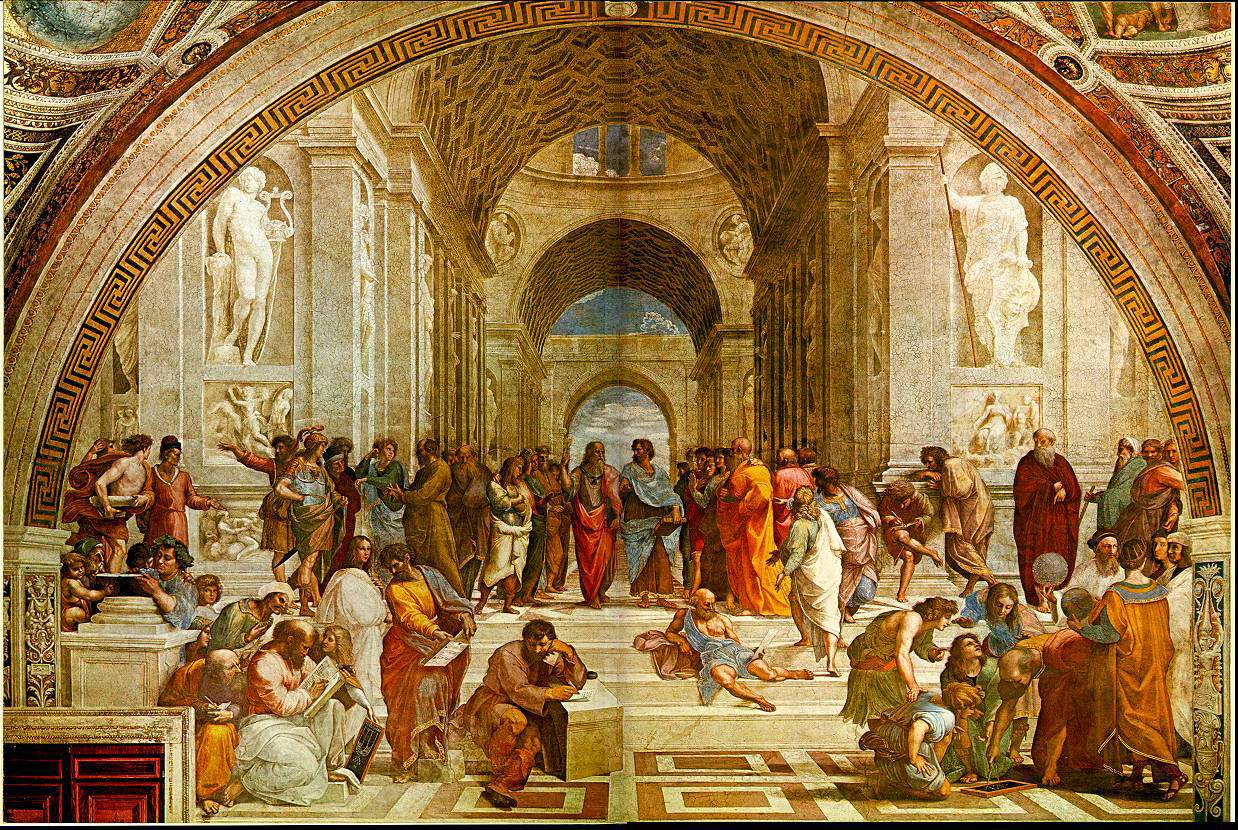Dan Brown finds great plots and conspiracies in renaissance and baroque art. We are on a different quest: wisdom and knowledge of the magnificent mental palaces we can use.
Philosophy visualized
The main role of artists in renaissance and baroque era was the visualization of complex ideas in an easy to remember form. The artists used to portray all the most important people and metaphors for their work. Most of the art then deal with religious subjects and was commissioned by clergy, but some wealthy patron commissioned depictions of classics.
One of such works of monumental cultural value is Rafael’s “The School of Athens“. We can see a PAO of all classical philosophy conveniently placed in one huge room. Using wikipedia as a guide we can understand the role of each figure and what it is doing with the relevant objects. Learn to visualize all details of the picture, and you have visualization anchors for most epic classical creations.
The central figures of Plato and younger Aristotle define the pivotal philosophical conflict of medieval times. All the details and even the gestures of the figures matter. Learn them, memorize them, and later reuse in other visualizations.

Itineraries
Entire medieval cities can be used as mental palaces. Follow Dan Brown’s “Angels and Demons”, and you have a great itinerary for half of Rome. For fun, you can visualize Illuminati symbols in key locations.
Now, you can define your own itinerary in Rome, Florence, Venice, or just Louvre. Do not visit all the masterpieces, but define which masterpieces you want to see. Now be careful and embed your own symbols within the major works. This is fun. Type in google image search “mona lisa jar jar binks” to see some examples.
Metaphors
Some imaged, like Jan Van Eyck’s Arnolfini portrait, embed a huge amount of detailed metaphors in every item in the room. Look under “interpretation and symbolism” in Wikipedia.
Other masterpieces like The Garden of Earthly Delights by Hieronymus Bosch is intended to be a very complex symbolic depiction of the earth and the scripture. This is a very complex image to remember in great detail, so try to choose a fixed itinerary within the image. Immediately you will find hundreds of details and symbols of complex life phenomena. You can reuse the imagery in your palaces. Put a pair of cherries on someone’s head and you get the detail for pride.
Not all medieval masterpieces have such a complex symbolic explanation. The tarot cards are pretty simple, but each card has several symbols with the same meaning.
Body language
The renaissance and baroque sculpture can show great examples of body language. Some of the poses are very standard and can be seen in many art pieces. Many poses tend to be arresting, sensuous, and almost unnatural. They were twisted to present motion and to show details. When we enter our mental palaces we want to review details as quickly as we can. Why not use the same poses?
Now watch the sculptures closely and try to refine the poses to make them more flowing. This way, when we review our mental palace the eye merely slows on each sculpture instead of a full stop. With some simple modifications, we reduce saccading and increase the speed of visualization.
Beauty is often practical, and if we take details from the artists, we can improve our own visualizations.
Composition
Renaissance art often portrays two kinds of composition: perspective design with a single focal point and a pyramid with an increasing number of details as we go down. The pyramid structure is basically a mindmap with each level multiplying the information. Perspective with a single focal point is a very comfortable depiction for mental palaces: we have a single point to focus on and can complete the image from peripheral vision.
If you want to think out of the box, consider the composition of Caravaggio’s paintings. Some present circular patterns. On some, the focal point is outside of the image. Quite often we see composition in triangles and diagonals, that the eye follows in Z-like fashion. When we create complex visualizations for the walls of mental palaces, we can reuse this composition. The eye can scan the room in a wavy or diagonal pattern and cover the entire walls quickly.
Baroque palaces often had many pictures in a small space. The owners enjoyed reviewing them quickly and often, stopping their gaze each time on different features. At least this is how I imagine them.
Colors
The renaissance colors were created from various natural compounds. Not all combinations could be used. Some colors were more expensive and were used sparingly on the most prominent features.
Why should our palaces be different? Not all emotions and ideas are equally important. We can use some of the most exquisite colors for more interesting details. This way we guarantee that even small details can capture the eye.
Ownership
If you happen to own one of the great masterpieces you are extremely lucky. Most of them are in state ownership and not for sale. If we created beautiful visualizations, they are ours and not for sale. We can enjoy revisiting them, and we are likely to revisit them. If we decide to change these visualizations, the changes will be relatively small to preserve the beauty of each detail.
When we want to remember something forever and enjoy revisiting it, why not mimic the renaissance art?

Get 4 Free Sample Chapters of the Key To Study Book
Get access to advanced training, and a selection of free apps to train your reading speed and visual memory
